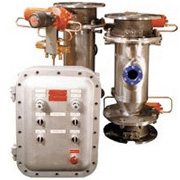Continuous vacuum dryer system eliminates batch variability
Problem: Schenectady Company needed a continuous vacuum dryer to match the continuous manufacturing process for making a resinous product. Drying had been carried out in batch dryers at the plant and through “contract” drying facilities, but increased production was needed to handle the demand for the products. A careful evaluation of equipment was essential to assure that any continuous dryer selected could be fed and discharged without clogging or jamming up, a common problem encountered when a continuous dryer is operating under a pressurized or vacuum environment.
The 1000 lb/hr of material to be dried is at atmospheric pressure. It is mildly abrasive, primarily 40 mesh, but with some pea sized lumps, and contains about 35% volatiles. The material was found to stick to heated surfaces at volatiles above 30%. The drying process must be carried out at about 100 mm of Hg absolute pressure. The heating media available is 40 psig steam. The dry product temperature is expected to be about 300 degrees F, and discharge from the dryer is to a bin at atmospheric pressure.
Solution: A steam heated, cut flight jacketed paddle-type, continuous processor was selected to dry the material. This is a recycle type unit, which conditions the feed by mixing a portion of dry material with the inlet stream. The 18″ diameter dryer is mounted horizontally and has pitched paddles, which convey the material along its 16′ length. The material spends about 1 hour in the dryer.
For best operation the dryer system has to run with the recycle equipment also under vacuum. A cost-effective design was obtained using an external recycle screw. The inclined mixer/conveyor used simplified the design and eliminated the need for other pieces of equipment. In it the solid feed is mixed with a continuously recirculating bed of material. This keeps the volatiles content in the dryer below 30%. The heating surfaces remain clean. The dryer stays in operation.
For feeding and discharging materials, the dryer supplier suggested airlock assemblies incorporating vacuum tight, spherical valves. The 4″ assemblies each consist of two spherical valves with an intervening chamber of about 0.5 cu ft. The valve discs wipe particles off the seating surfaces while closing so they do not crush or leak fines. The airlocks are installed with the discs facing toward the dryer (vacuum chamber), so that atmospheric pressure helps seal the valves.
 The airlock valves are controlled by programmable controllers, one each for the feed discharge. The operating sequence on the airlock begins with opening the top valve with the bottom valve closed to allow material to fall into the intervening chamber. Then the top valve is closed and the chamber pressure equalized. The bottom valve is not opened until the pressure in the intervening chamber equals the pressure at the discharge of the bottom valve. Finally, the bottom valve is opened to allow discharge of the material from the chamber. Because there is no blow-by or leakage through the closed valve, the chamber reaches the pressure of the dryer or the feed or discharge bin quickly without any material packing or plugging problems.
The airlock valves are controlled by programmable controllers, one each for the feed discharge. The operating sequence on the airlock begins with opening the top valve with the bottom valve closed to allow material to fall into the intervening chamber. Then the top valve is closed and the chamber pressure equalized. The bottom valve is not opened until the pressure in the intervening chamber equals the pressure at the discharge of the bottom valve. Finally, the bottom valve is opened to allow discharge of the material from the chamber. Because there is no blow-by or leakage through the closed valve, the chamber reaches the pressure of the dryer or the feed or discharge bin quickly without any material packing or plugging problems.
The flow rates are determined by the production rate upstream of the dryer. The airlock valve action can be speeded up or slowed down to match the flow rates of the feed and product streams. Dryer feed and discharge airlocks are independently controlled. The reason is that, when the solid content of the feed stream varies, the feed valve action can be changed while the discharge rate remains steady. The valves are pneumatically actuated.
Vacuum for the dryer is obtained by exhausting non-condensables with a liquid-ring vacuum pump powered by a 25 hp electric motor. The vacuum pump connects to the dryer’s 100 sq. ft. surface condenser. Cooling water is supplied to both the condenser and the vacuum pump.
Results: The dryer system including feed and discharge airlocks have worked dependably with no plugging. They essentially have required no attention or maintenance except for speed adjustment. The continuous dryer system has permitted increase production and improved product quality by eliminating batch variability. It takes only one operator to run the dryer system compared to several required for drumming and transfer for the batch process.
Continuous vacuum dryer system eliminates batch variability, matches upstream continuous process.
